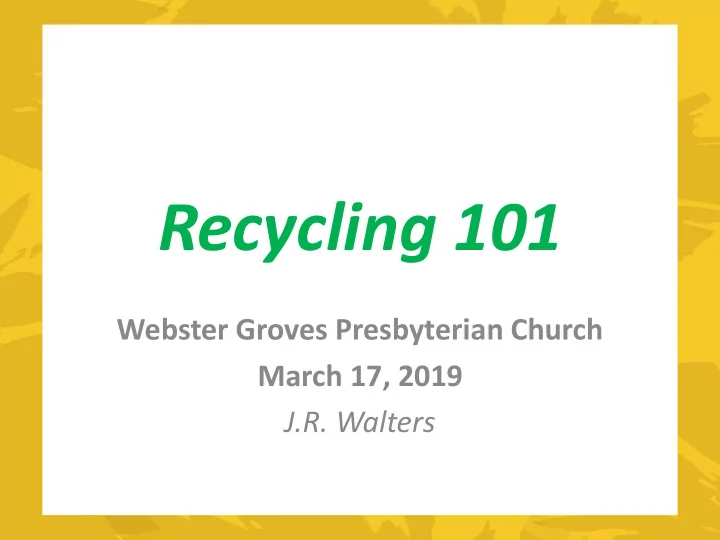

Recycling 101 Webster Groves Presbyterian Church March 17, 2019 J.R. Walters
The Problem One Day We make, use, and throw away a lot of stuff! On average a person in the U.S. produces approximately 4.48lbs of waste each day.
The Problem One Week We make, use, and throw away a lot of stuff! On average a person in the U.S. produces approximately 4.48lbs of waste each day. In 2015, Americans generated 262 million tons of trash. How much of that was recycled or composted? Approximately 91 million tons recycled or composted
Understanding the Problem Total MSW Generation (by Material), 2015 ● 262 Million Tons (before recycling) ● 91 Million Tons (35%) diverted for recycling or composting ● Average of 4.48lbs of waste generated per person per day
So What do We do to Solve the Waste Problem? First, Use Less – REDUCE Second, Repurpose or REUSE Last, RECYCLE!
The waste stream is more complicated than simply throwing stuff in the correct bin. There are many places for waste to be disposed of, and many paths for waste to take to get there. Follow the chart below to the different paths of our complex waste stream.
Terminology Single Stream – All “fiber” and ‘container” materials accepted for recycling can be combined in a one-bin collection system. Contaminant – Any material not acceptable in a recycling collection system. Contaminants can include kinds of materials (like plastic bags) or “goopy” items that compromise the quality of other single stream materials. Hauler – The company that literally picks up your recycling from home, workplace or school. This company is typically the “face” of recycling for you, but many haulers are an intermediary between the customer and the point of processing recycled materials on their way to becoming resources for recycled-content manufacturing. Haulers also haul to landfills.
Terminology MRF – Materials Recovery Facility – Industrial plant, often highly automated, where recycled materials are sorted from co- mingled “single stream” collection into their unique material streams, so that these materials can be brokered (sold) to manufacturers wanting them as ingredients for recycled-content new products. ALL single-stream recycled materials go through a MRF after they are picked up by a Hauler. Markets – Global manufacturers want recycled materials as ingredients for making new products. However, many of these markets are now rejecting loads of materials that are contaminated! Landfill – Facilities that accept and contain a wide variety of “waste” materials. Landfills are highly regulated and monitored. Landfills are not bad! BUT why would we send materials that still have “useful life” to be buried a landfill?
The Landfill Top Things in Landfills: 1) Paper 2) Organics (Yard & Food Waste) 3) Plastics
Commercial Composting
Special Collections ● Grocery Store Plastic Bag/Film Collections ● St. Louis Household Hazardous Waste ● Multiple collector Events ○ Electronic (E-Waste) ■ MRC ■ EPC
What Happens to Recyclables?
MRF: Material Recovery Facilities St. Louis Area Facilities •They Recycle over 300 Tons per Republic Services, Hazelwood day, at just one facility! Resource Management, Earth City
Cardboard Screen and Glass Crusher
Container Line
Steel Magnet
Eddy Current
Optical Sorter 1 – PET Plastic
Optical Sorter 2 – HDPE Plastic
Optical Sorter 3 – Aseptic Packaging/Cartons, Other Plastic
Clear. Consistent. Concise. Recycling labels that make sense. Preparing Material for Recycling Information is provided to ensure the proper steps are taken to effectively recycle materials. How2Recycle Information and locational instructions let you know if an item can be recycled traditionally or by other means. Not Yet Recycled Limited Recycling * Not recycled in all Widely Recycled Store Drop-Off communities Type of Recyclable Material Lists what type of material the packaging is made from. Lists Recyclable Parts of Packaging Information on what parts of the packaging needs to be recycled in this specific way. The Multi-Component Labels We want to be sure that you know how to recycle your whole package, not just a part of it! For a How2Recycle label like the one at right, each "tile" represents a different part of the package. This is really helpful for when you're trying to know how to recycle different parts of your package. How2Recycle labels are intended to be read left to right, based on which part of the packaging you encounter first.
Recycling Facts • An aluminum can takes only 60 days to be repurposed into a new can • If all our newspaper in the world was recycled we could save about 250,000,000 trees a year! •Recycling one ton of plastic saves the energy equivalent of what it takes to turn 1500 gallons of petroleum into gasoline • Recycling creates 8 times as many jobs as incineration and landfills • It is cheaper to make material from recycled material than it is to make it from scratch
Online sources: http://how2recycle.info https://search.earth911.com / https://berecycled.org /search/
Recommend
More recommend